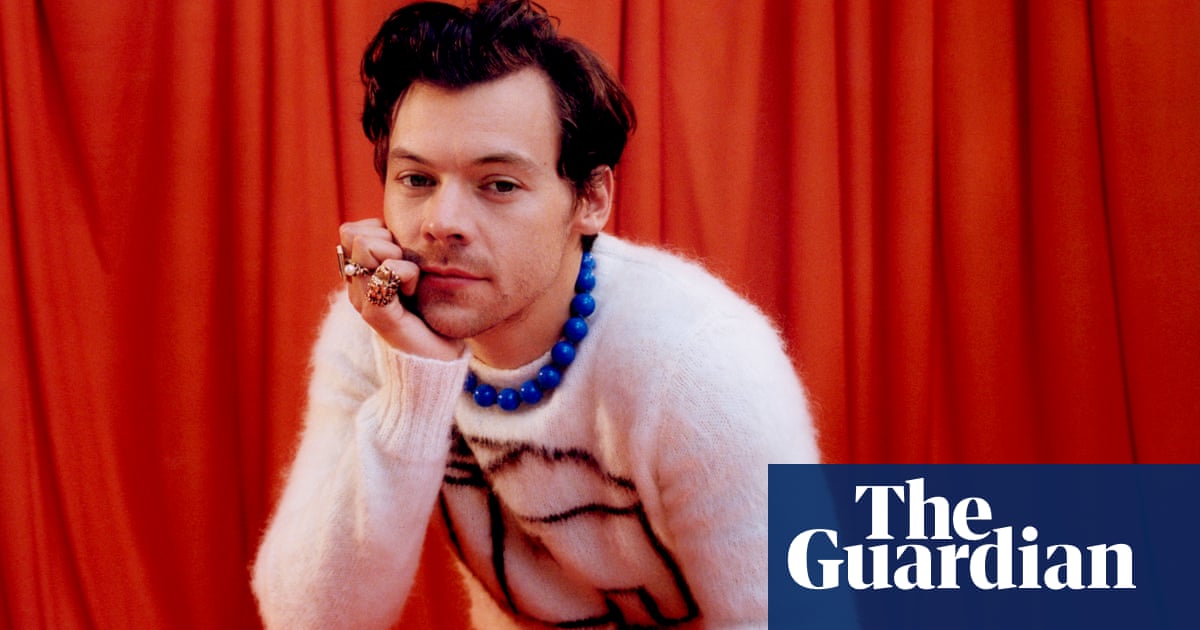
All back to mine: Harry’s House sets domestic tone for 2022 Mercury prize
It was perhaps inevitable that so many records born of the last couple of years should possess a certain interiority. Tours halted, venues closed, the world on hiatus. Meanwhile Britain was in a period of self-examination: its history of slavery, its attitudes to gender, its post-Brexit reckoning and repositioning.
Accordingly, many of the albums shortlisted for this year’s Mercury prize reflect this time: preoccupying themselves with ideas of belonging, identity, home. From Little Simz’s Sometimes I Might Be Introvert to Joy Crookes’ Skin, Fergus McCreadie’s Forest Floor to Sam Fender’s Seventeen Going Under, they have captured something of our containment and our scrutiny. They bring us south London, Cornwall, North Shields, rural Caledonia; gentrification, race, the Department for Work and Pensions. Kojey Radical winds his album down with the voice of his mother. Gwenno opens Tresor with a homely invitation: “Welcome, sit down / Fancy a cuppa?” These are songs that move close, closer, closer still.
For Harry Styles, this was perhaps a taller task. Where does an international pop star belong? In London? In Los Angeles? Or somewhere mid-air, in that strange, un-landed space between arena tour and pin-up poster, think piece and TikTok trend? After all, we want to feel close to our megastars – to know who they’re dating, their favourite colour and what they ate for breakfast. And yet we also want them to remain unsullied by domesticity, and all of the humdrum tasks that weight our pale civilian lives. If we must see them at home, let it be in sumptuous lifestyle spreads so we can wonder at the threadcount of their sheets and the vastness of their sofas. Or give us the heightened pop houseshare of the Monkees, absurd and bright and delightful. Let them go back to the land, buy farms, wear wellingtons – let them shear sheep like Paul McCartney on Ram. Let them make wine and cheese and write cookbooks. May they never know the mortal horrors of bin juice and mildew and dust.

It feels slightly discombobulating to think that Styles might even have a home at all. At 28, he is still recognisably the rumple-haired teen we first met through a British TV talent show, but grown now into pop star, film star, heartthrob, fashion icon, with platinum album sales, Grammy awards, Vogue covers. One pictures him on a stage, or in fine hotels, perhaps bare-chested in a music video. He is surely too young and too shiny to retreat into domestic bliss, and seemingly also too self-aware to occupy the world of soulless penthouse bachelor pad. How to maintain, then, this pleasing starriness while also delving deeper? How to talk about those same ideas of belonging, identity, home, without seeming removed? How to draw the listener close while still carrying a lustre?
After lockdown stymied his second album tour, Styles returned to LA in early 2020 and lived with friends. It was a peculiar feeling – the first time since X Factor stardom 10 years earlier that the singer had been in one place with some semblance of normality. And with that came a kind of levelling, a confrontation of the self. For a while he did not write music, but focused instead upon nurturing the relationships he had somehow evaded as he zig-zagged around the world. He thought about his family back in the UK. He thought about friends and romantic partners. He thought about all of the rooms within himself that therapy had opened up, and how, perhaps, they might make a place to settle down.
In an improbable, but exquisitely on-brand album-launch interview with Better Homes and Gardens, Styles described the realisation that came once the world retreated and the screaming stopped: “That home feeling isn’t something you get from a house; it’s more of an internal thing.” Later, when he came to write and record the material that would eventually make up Harry’s House, he wanted to carry this feeling into the new songs. “Imagine,” he said, “it’s a day in my house, what do I go through? A day in my mind, what do I go through? In my house I’m playing fun music, sad music. I’m playing this, I’m playing that. It’s a day in the life.”
In music, intimacy is a careful art, and Styles has mastered it with tenderness and wit. The album’s title nods to both Haruomi Hosono’s 1973 album Hosono House and Joni Mitchell’s 1975 track Harry’s House/Centerpiece, but also feels like an invitation akin to Gwenno’s “Welcome, sit down / Fancy a cuppa?” The cover shows Styles standing on the ceiling of a suburban living room, looking something like an early 70s Hockney painting. The room small, the decor plain, the inversion seeming to acknowledge the familiar world turned upside down.

One might’ve expected a stripped-back acoustic style for his most personal record – this having become the accepted shorthand for authenticity and musical proximity. But this isn’t the down-home stylings of Dylan’s Nashville Skyline, or the sparse isolation of Bon Iver’s For Emma. Rather it’s an album that ranges from soft rock to synth-pop via funk and R&B. Not as maximal as 2019’s Fine Line, but still marked by grandeur and ambition. Instead, Harry’s House finds closeness elsewhere. The songs here are strewn with the paraphernalia of the domestic and the everyday, and while it never quite reaches for kitchen-sink realism, there are tracksuits and ponytails, spilled beer, stubbed toes, broken ankles, and drinking red wine in the garden, a couple of glasses deep.
The glamour of his life is largely toned down or undermined. When one character does cocaine, it’s at the kitchen table. In Little Freak, another sits high atop a kitchen counter. He’s walking and riding bicycles as often as he’s singing of aeroplanes and top-down sportscars. He’s talking of Hampstead Heath and Bishopsgate as much Hollywood. While album closer Love of My Life comes off like a love song, Styles has explained it is in fact about his feelings towards his time living in London – how for all the splendour of Los Angeles, he misses Sunday afternoons strolling through his old home, getting to know “your creases and your ends”. It’s a beautiful and unexpected image – sensuous and palpable, the city writ as lover’s body.
Styles’s great trick on Harry’s House was to make a pandemic-days album heavy with such tactility. If stardom prevented a full emotional confessional, if the untethered, rarefied life meant there was little room for geographical observation or political reflection, instead he gave us a collection of songs we could feel. Across these 13 tracks, Styles sings of honey and maple syrup and pancakes, fried rice, ice cream, “cooking an egg on you”. There is the layered repetition of a “bottle of rouge” and, later, red wine and ginger ale; there is both coffee on the stove and coffee for two. There are palms of hands, birthmarks, choking, side boob. There is bubblegum twisted round tongues. Egg yolks. Hot wax. Kissing. It is an album sticky with proximity.
On Satellite, Styles gives us what appears to be a love song of separation and avoidance; a subject one imagines the global pop star is well qualified to tackle. But in this context it captures, too, something of the absence we all felt when life was lived in slow, distant orbit. The loneliness, the unspokenness, the days spent watching others from afar. It only makes the rest of the songs on Harry’s House feel closer, warmer, stickier. “I’m right here,” he sings repeatedly, as if half in reassurance to another, half in revelation to himself. Finding that home feeling, the new rooms within, a place at last to belong.
It’s a similar sense that runs through the work of his fellow nominees. To the casual onlooker, the Mercury longlist, with its metal and its megastars, might appear a disparate collection of artists, but still a thread runs between them – Self Esteem finding surety in her self, Nova Twins defiant in the face of anyone surprised to find two young Black women playing metal, Yard Act staring down the barrel of post-Brexit Britain. Amid political upheaval, the pandemic, the mounting turbulence of war and recession, this broad community of nominees offer a portrait of modern Britishness: how an uneasy relationship with our country necessitates finding a home within ourselves.











































![iFi's GO Bar Kensei Dongle DAC Supports K2HD Technology With Some Samurai Swagger [Updated] iFi's GO Bar Kensei Dongle DAC Supports K2HD Technology With Some Samurai Swagger [Updated]](https://i0.wp.com/cdn.ecoustics.com/db0/wblob/17BA35E873D594/33FF/45A11/QTXOLJR4xDKSNMMk2WlTgjaIlvSgcYpeU1xJzUwIoYs/ifi-go-bar-kensei.jpg?w=768&ssl=1)































